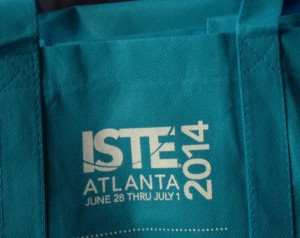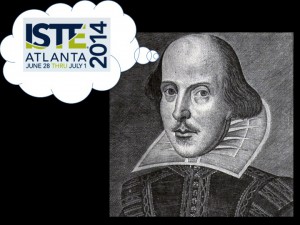 OK, superheroes and superhero wannabes, now is the time to choose or renew your superpowers. It is summer, time for professional development and personal improvement among educators. The fortunate among us will be traveling to ISTE later this month, but most teachers and ed tech coaches must find their own PD to sharpen our powers. Ed tech coaches, in particular, have quite a challenge finding meaningful formal PD, and most of us turn to Twitter, edcamps, unconferences, and online collaboration/sharing to hone our superpowers. Now is the time to ask yourself:
OK, superheroes and superhero wannabes, now is the time to choose or renew your superpowers. It is summer, time for professional development and personal improvement among educators. The fortunate among us will be traveling to ISTE later this month, but most teachers and ed tech coaches must find their own PD to sharpen our powers. Ed tech coaches, in particular, have quite a challenge finding meaningful formal PD, and most of us turn to Twitter, edcamps, unconferences, and online collaboration/sharing to hone our superpowers. Now is the time to ask yourself:
If I could carry just ONE superpower into next school year to rescue LEARNING for my teachers and students, what would it be?
Here is a starter list from which to choose:
Filter Flummoxing: This fantastic flummoxing capability allows the superhero to perplex arbitrary or obtrusive web filters so they defer to the superhero’s wisdom, thereby allowing the powers of web-based learning into any classroom. The superhero can instantly fend off the filter without filling out forms, attending administrative meetings, or enduring tedious time delays. Note: If the superhero abuses this power, it will fade away, so use it wisely.
Parent Persuasion: This power permits the superhero to cast a spell over the most skeptical parent, instilling a glow of understanding that signs off on GOOD uses of technology and eschews frivolous or glitzy projects. As with all superpowers, the superhero should think carefully before using (or abusing) it.
Administrative Awe and Buy in: Imagine an administration that looks in awe upon student-directed learning, technology-infused projects, and collaborations that connect classrooms via Twitter and other “scary” tools. Imagine an administration in awe of the positive powers of technology and willing to learn it themselves as a model for their teachers, parents, and students, all within a framework of good digital citizenship that charges students (and teachers) to use resources ethically and demonstrate positive online behavior. If you choose this as your superpower, you will have administrative support at the wave of your cape.
Super Spider-webbed PD: As a superhero, you can swoop in only where professional development parameters allow you to go. By casting a spider-web onto all PD, you can incorporate technology as a logical pat of ALL teacher PD instead of separating it out. This superpower lets you tie technology into its logical place in support of any learning. Superpower spider webs never let go!
Time Control: Just as it sounds, this power allows the superhero to stop the sands of time long enough for a teacher to take a breather and make a few mistakes along the way to infusing technology in support of learning. Think of Superman holding back the hands of the gigantic clock over Gotham City Hall (or the one on the school hall). Wouldn’t that come in hand-y?
Envisioning Glasses: Give these high-powered glasses to any teacher, and he/she will see what you can see. Teachers will be able to focus on what technology does, not the work it takes. Think of these envisioning glasses as the heads-up display teachers can wear as they guide their craft wisely into the sky.
Gumby mental flexibility: Superheroes must be able to bend their plans, reshape their thinking (and that of others), and adapt to limitations at a moment’s notice, never straining a mental muscle. Stretch yourself as far as you need to go and around corners with this superpower. Amazingly, you will be able to shrink back to normal dimensions after the stress abates.
Access Prowess: The ability to provide access to functioning technology anywhere and anytime it is needed. Use this Prowess to enable any teacher or student to have a fully-functioning, web-connected device whenever learning demands it. This Prowess extends outside the school walls to home access for learning and inside school facilities, demolishing barriers from scheduling debacles, drill-and-kill test prep, or online testing monopolies.
Tech Invisibility Cloak: Most superheroes secretly enjoy flaunting their powers, but making technology invisible will ultimately win more battles over ignorance. If you had this power, you could make technology a seamless and appropriate part of learning, and no one would notice it as technology. They would see only the learning.
Glitch force field: Fend off the forces of Glitch with this amazing force field. Need the Internet? It will work on ALL machines. Need Google docs/drive/apps? No problem. Just deploy the force field, and things magically WORK! Of course, you have to recharge it periodically by actually maintaining equipment and network, but the time you save fixing weird glitches will provide plenty for prevention.
Can’t find your superpower of choice? Please share it in a comment or at the Coaching Playground at ISTE later this month. We’ll be there, caped and ready!
 triggered by something totally innocent: the feel of cool tile on bare feet, the rush beneath the surface of the water as I push off the pool wall, the sound of a favorite song playing as I sing along in a convertible, the lightning bugs after the fireworks end. At first the valve seems a bit creaky, crying out for WD40 on the brain, but soon enough it lets ideas flow freely again.
triggered by something totally innocent: the feel of cool tile on bare feet, the rush beneath the surface of the water as I push off the pool wall, the sound of a favorite song playing as I sing along in a convertible, the lightning bugs after the fireworks end. At first the valve seems a bit creaky, crying out for WD40 on the brain, but soon enough it lets ideas flow freely again.













